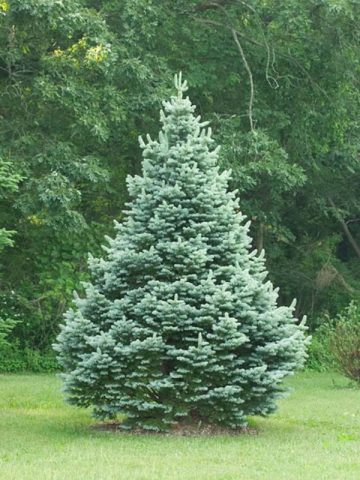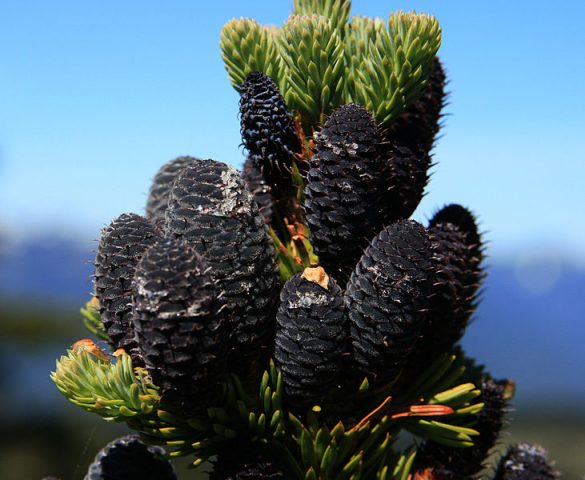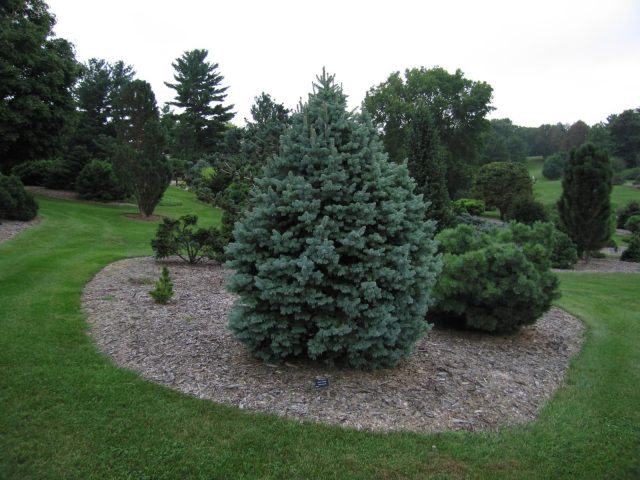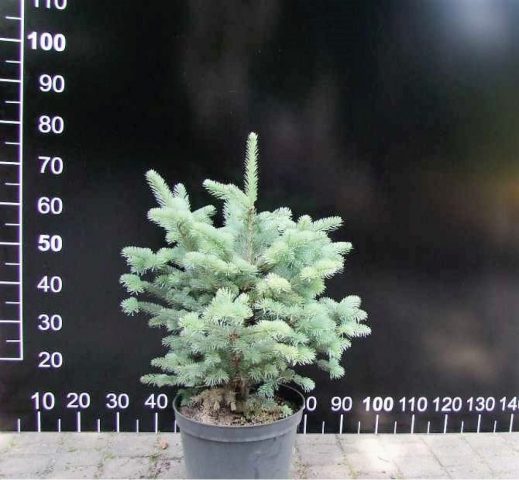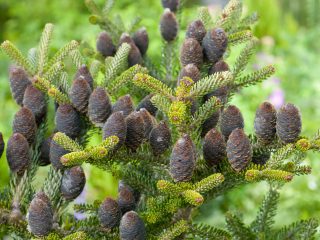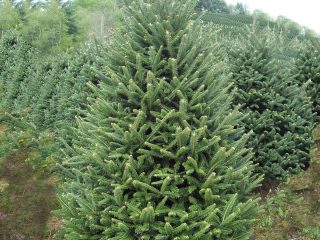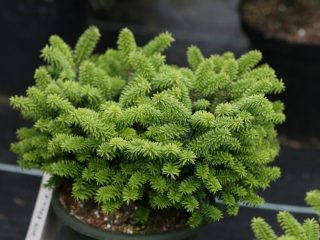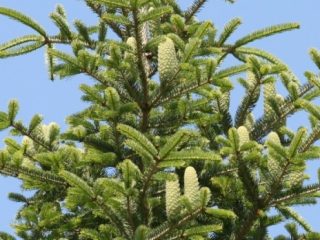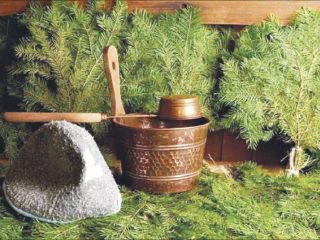Content
Mountain fir Compacta has several synonyms: subalpine fir, lasiocarpa fir. The subalpine culture is found wild in the highlands of North America. Due to its compactness and unusual appearance, it is often used in landscape design.
Description of subalpine fir Compacta
Mountain subalpine fir Compakta is one of the best decorative dwarf varieties. According to the description, the decorative properties of the Compacta mountain fir shown in the photo are as follows:
- compact crown dimensions;
- blue needles;
- tough short branches that allow you to survive snowfalls without much damage.
The shape of the crown is wide-conical, the height of an adult seedling at the age of about 30 years does not exceed three meters, the diameter is from 2 to 2.5 m. The tree grows slowly, especially at a young age.
The shoots have an ash-gray tint with slight rusty pubescence. The needles are short, not prickly, and have a silvery-bluish tint.
The cones have an oblong-cylindrical shape. The color of the cones is violet-blue, the average length is about 10 cm. The cones on the shoots are located vertically upward.
Mountain subalpine fir Compacta loves fertile lands with moderate moisture. It tolerates periodic excess moisture well. The soil acidity (pH) for growing this variety should be in the range from 5 to 7. The crop grows poorly on loamy soils with high humidity. Carbonate soils can be used for growing Compacta mountain fir. Can grow in sunny and semi-shaded areas.
Compact fir in landscape design
Mountain subalpine fir Compacta is widely used in the designs of landscape designers. It is used to decorate alpine hills and planted in heather and rocky gardens.
This evergreen tree will decorate your garden plot all year round, the main thing is to follow the rules of caring for it.
Planting options for mountain subalpine fir Compacta:
- in the center of a lawn or flower bed;
- along the wall of a building or fence;
- in a row to create a hedge;
- along the alley.
Planting and caring for subalpine fir Сompacta
It is best to purchase a seedling of mountain subalpine fir Compacta from a specialized nursery located in the same climatic region where the seedling is planned to be planted. Trees in the nursery are sold with a closed root system in containers in which all the necessary nutrients are added, so you don’t have to worry about fertilizer at the time of planting.
Preparing seedlings and planting area
The seating area for Compact fir should be well lit. Areas with periodic shading are also suitable. It is better not to plant mountain fir in the shade of other trees, since the tree is a light-loving specimen.
If the seedling has an open root system, before planting the tree should be soaked in a solution that accelerates root growth.Experts do not advise purchasing coniferous seedlings with bare roots, since they practically do not take root.
If the seedling is purchased in a pot, it is watered well and removed along with a lump of earth.
Landing rules
The best time to plant a seedling is early spring before buds open, or autumn, long before frost.
The planting pit is prepared in advance. At least two weeks before planting, dig a hole measuring 60x60 cm and 70 cm deep. The dimensions are approximate, since it all depends on the size of the earthen ball or the volume of the roots.
A drainage layer is placed at the bottom of the pit, which is used as crushed stone, brick fragments, and sand. The drainage layer should be at least 5-7 cm.
The planting hole is filled with a nutrient soil mixture consisting of the following components:
- humus - 3 parts;
- peat – 1 part;
- sand – 1 part;
- sawdust – 1 part;
- nitrophoska - 200 g per planting hole.
The roots of the seedling are covered with soil, compacted and watered. When planting in groups, a distance should be maintained: 2.5 m for a dense planting and 3.5 m for a loose group. When planting fir along an alley, you can leave 3.5 to 4 m between seedlings.
Watering and fertilizing
After transplanting the subalpine mountain fir Compacta to a permanent place, it should be watered regularly. Young seedlings need watering, otherwise they may not be accepted. Older tree specimens make do with 2-3 waterings per season. If there is an abnormally dry summer, the number of waterings can be increased; the crown is additionally sprinkled in the evening hours.
Seedlings purchased from nurseries already have a supply of fertilizers, which is enough for the full development of fir. If the tree is grown independently, the fertilizers applied during planting will provide a supply of nutrients for 2-3 years, after which in the spring complex fertilizers, for example, Kemira-universal, are applied to the tree trunk.
Mulching and loosening
After planting mountain subalpine fir, it is advisable to mulch the tree trunk circle with available materials. This could be sawdust, peat, tree chips. Spread the mulch in a thick layer (5-9 cm).
Loose the soil after watering, do this to a depth of 10-12 cm, so as not to damage the root system of the seedling. The loosening procedure is necessary to saturate the rhizomes with oxygen and remove weeds.
Mulching protects the soil from drying out and prevents reproduction and growth. weed, and also protects the roots from freezing in winter.
Trimming
Compacta fir naturally has a beautiful crown shape, so pruning is resorted to only in case of breakage or damage to the branches.
Formative pruning is not performed, but sanitary pruning is performed in spring or late autumn.
Preparing for winter
Young firs should be covered for the winter. A mulch layer will help protect the roots from freezing; the crown is wrapped with agrofibre and covered with spruce branches. You can install a wooden tripod support to protect the branches from heavy snowfall.
Mature firs do not need shelter, but it is advisable to renew the layer of mulch around the roots before the onset of frost.During periods of snowfall, the branches of the Compacta mountain fir may suffer, so wet snow is carefully brushed off the crown.
Reproduction
Mountain fir Compacta is propagated in two ways:
- seeds;
- cuttings.
The first method takes a lot of time and is not always effective. In the fall, cones are collected, dried and the seeds are extracted. To harden planting material, the stratification method is used. Subalpine fir seeds are placed in damp sawdust and sent to the bottom shelf of the refrigerator for several months. Monitor the moisture content of the soil with seeds - it should not dry out or be too wet. Seeds are planted in spring or autumn. Cover the top of the container with seeds or the bed with a film; after the emergence of seedlings, the film is removed.
Cuttings produce a mature tree much faster than the seed method. A one-year cutting at least 5 cm long and having 1 bud is torn from the top of the tree. The cuttings are not cut off with pruning shears, but are torn off with a sharp movement from the mother branch in order to obtain a shoot with a heel. Work on preparing cuttings is carried out in cloudy weather. For cuttings, select shoots located on the north side. Before planting, the cuttings are immersed for several hours in a weak solution of manganese. To plant subalpine fir, prepare a nutrient mixture consisting of humus, sand and leaf soil, taken in the same ratio. The cutting is covered with a glass jar. The jar is periodically raised so that the cuttings are ventilated and get used to the surrounding conditions.
Diseases and pests
Subalpine mountain firs have good immunity to pests and diseases, so compliance with agricultural practices helps prevent the risk of tree damage.
Mountain subalpine fir trees are parasitized by Hermes spruce-fir, which can be controlled by spraying the trees in early April with Antia and Rogor-S. For 10 liters of water you will need 20 g of insecticide. These drugs are used to combat fir moth and pine budworm.
When subalpine mountain fir Compacta is damaged by rust, the crown is treated with Bordeaux mixture. Fallen pine needles are removed and burned, damaged branches are cut off and also burned. To prevent infection and further spread of the disease, the cut areas are treated with garden varnish.
Conclusion
Mountain fir Compacta is an evergreen coniferous tree with a beautiful wide-conical crown. Used as a landscaping agent for alleys, garden plots, and home areas. Caring for the Compacta subalpine fir does not require much effort, so the tree is often planted in dachas to decorate the area.
